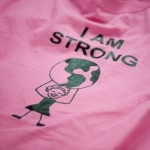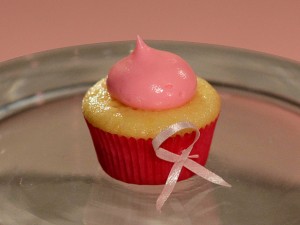This essay was written by Molly Brenner, a senior at Vassar College I met after giving a lecture on pink ribbon culture. It was originally published on Pink Ribbon Blues.
—
In the summer of 2010, I worked as a Program Operations intern at Strong Women, Strong Girls, a nationally recognized after-school mentoring program for girls in grades 3 through 5. The organization focuses on teaching girls how to build relationships and skills while modeling these characteristics through historical and contemporary “strong women.” Each fall, college women such as myself work as mentors for the program to teach girls the “Countdown to Success Skills Curriculum,” which focuses on different skills that research has identified as being essential for girls’ healthy development. Then in the spring, mentors lead the the girls in a service project to develop leadership skills and civic responsibility in their communities. As a Program Operations intern, I helped to draft the 2010-2011 curriculum. Beyond giving me a window into the non-profit world and curriculum development, however, the organization offered me a perspective on the color pink.

Strong Women, Strong Girls uses pink branding for a purpose. Coupled with the logo of a stick figure girl who is wearing a dress and lifting the world above her head, the organization recognizes that girls need communities of women, both peers and mentors, to build self-esteem, leadership potential, and mutual respect. Without such environments, studies find that girls’ self-esteem tends to decrease with age thereby limiting their opportunities to develop successful skill sets and relationships. In providing a supportive structure, the organization aims to reclaim pink, not as a symbol of the weaker sex but as a symbol of feminine strength.
Following my summer internship I returned to college in the fall where I took a course from Professor Janet Gray on the BioPolitics of Breast Cancer, which complicated my perspective on the uses of the color pink. As a Media Studies major with a concentration in gender and popular culture, the class interested me because I had yet to study the intersection of medicine and feminist theory. In this class we examined the deeply complex economic, medical, and social issues that envelop breast cancer. Among these is the color pink and its use in the mainstream breast cancer movement. For example, the course began with Barbara Ehrenreich’s article, “Smile! You’ve got cancer,” in which she addresses pink’s role in “sugar-coating” and feminizing the experience of having breast cancer, which affects people of all gender identities.
My education on the breast cancer movement was deepened further when Dr. Gayle Sulik gave a lecture at the college later that semester following the publication of Pink Ribbon Blues. She presented a collection of images, quotations, and statistics that revealed pink’s key, often insincere role in breast cancer cause marketing, along with its overall hyper-feminization of the mainstream movement. I developed an understanding of how the color pink could be used to signify feminine sexuality, heteronormativity, cheerfulness, and docility in ways that could be alienating to women and men both within and beyond the breast cancer movement.
Having had such varied experiences with the color pink, I explored the topic in a blog for the Strong Women, Strong Girls website, which started earlier that fall. In a post titled “Pink Thinking” I briefly looked at the different meanings of the color pink that I encountered through the Strong Women, Strong Girls program, the mainstream breast cancer movement, and the academic settings like those of Professor Gray’s class and Dr. Sulik’s lecture and book. I discussed the potentially problematic aspects of using pink as the face of a movement, but also the idea of reclaiming the classically feminine color for feminist purposes, as a number of organizations do. Ultimately, I raised the question about how pink functions variably in different contexts and with different effects.
As my exploration in my blog post reveals, I personally struggle with the color pink for the same reasons that Dr. Sulik outlines in Pink Ribbon Blues. I find it difficult to detach the pink connotations of products like pink ribbon barbie from heteronormativity, cheerfulness, and other traditionally feminine traits. I also believe that, in the breast cancer movement, pink enables a certain degree of ease in “activism” that undermine’s its potential.
 For example, in an October episode of the Food Network program Cupcake Wars, contestants were asked to make a cupcake using pink ingredients in honor of Hard Rock Cafe’s Pinktober concert event. As Dr. Sulik pointed out in her lecture, sugar actually feeds cancer and diet and exercise are part of cancer prevention, making sugary cupcakes an ironic part of breast cancer activism. Moreover, this episode exemplifies the ways in which pink consumption, as Dr. Sulik calls it, has become synonymous with “action” when in fact making pink cupcakes is not really the same as, say, caring for the diagnosed, learning about the complexities of the disease, or funding breast cancer research. It’s just a fun thing to do.
For example, in an October episode of the Food Network program Cupcake Wars, contestants were asked to make a cupcake using pink ingredients in honor of Hard Rock Cafe’s Pinktober concert event. As Dr. Sulik pointed out in her lecture, sugar actually feeds cancer and diet and exercise are part of cancer prevention, making sugary cupcakes an ironic part of breast cancer activism. Moreover, this episode exemplifies the ways in which pink consumption, as Dr. Sulik calls it, has become synonymous with “action” when in fact making pink cupcakes is not really the same as, say, caring for the diagnosed, learning about the complexities of the disease, or funding breast cancer research. It’s just a fun thing to do.
 Similarly, while in Sephora about a month ago I noticed a bin of pink compact hairbrushes emblazoned with the breast cancer ribbon. When I asked an employee if the proceeds from the product went to a specific organization, she was unsure. Later I found the product on Sephora’s website: “Sephora’s well-known popup travel brush is available for a limited time in a pretty pink color with a ribbon signifying support for breast cancer awareness. It folds shut into a compact size, perfect for your purse or travel.” It turned out that 1$ of each purchase for a limited time went to the Breast Cancer Research Foundation. I found it strange that such information was unavailable in the actual store. But it was also telling that a beauty product could so easily be made over to appear progressive and important, yet feminine. With these kinds of products, I find pink not only to be problematic in what they signify but also in the kind of “activism” they create. As if gazing at myself in a mirror and combing my hair represents empowered and meaningful social action?
Similarly, while in Sephora about a month ago I noticed a bin of pink compact hairbrushes emblazoned with the breast cancer ribbon. When I asked an employee if the proceeds from the product went to a specific organization, she was unsure. Later I found the product on Sephora’s website: “Sephora’s well-known popup travel brush is available for a limited time in a pretty pink color with a ribbon signifying support for breast cancer awareness. It folds shut into a compact size, perfect for your purse or travel.” It turned out that 1$ of each purchase for a limited time went to the Breast Cancer Research Foundation. I found it strange that such information was unavailable in the actual store. But it was also telling that a beauty product could so easily be made over to appear progressive and important, yet feminine. With these kinds of products, I find pink not only to be problematic in what they signify but also in the kind of “activism” they create. As if gazing at myself in a mirror and combing my hair represents empowered and meaningful social action?
Yet Professor Gray’s class also led me to think about breast cancer on the individual level as a unique experience for those who are diagnosed. Knowing that there are those who identify with pink solidarity and feel empowered by its use in the breast cancer movement, I believe in supporting these people just as much as I believe in questioning pink when it is alienating to others or producing negative results. Moreover, I think that support for the breast cancer movement can also come in the form of raising discussions like this one, which is what led me to write the post for Strong Women, Strong Girls. In any organization that uses pink, it is useful to invite a dialogue about the color, what it signifies, and how it fits in with organizational aims. In writing a post about pink this was my goal: to introduce an open dialogue within the Strong Women, Strong Girls program about the color and its place in a mentoring program for young girls.
I was initially a bit concerned about writing the post since pink is such an integral part of the organization. Though writing about a sensitive organizational issue, no changes were made to my post before being published to the blog, and the blog’s moderator sent me positive feedback about how I had navigated a sensitive organizational issue. Although the blog has not yet produced the full dialogue I had hoped, publishing the piece revealed a willingness on the part of the organization to foster open, unedited discussion about topics of their bloggers’ choosing. This, I see as positive.
Ultimately, the color pink has multiple meanings. Due to its many associations in cultural memory, from Barbie to the Feminist Majority Foundation, it will be interpreted differently based on the context. Because there is no single, right answer about what the color pink means or how it should be used, inviting discussion is what I find most essential in places where pink may go unquestioned. I hope that writing here will further this kind of discussion.
—
Brief Biography:
Molly Brenner was a senior at Vassar College majoring in Media Studies, with a focus on representations of women and gender in the media. She wrote her senior thesis about niche marketing and gendered audiences on cable television. In the summer of 2010, she worked as a Program Operations intern at Strong Women, Strong Girls in Boston, and the previous summer, she was a Media Relations intern at the Global Fund for Women in San Francisco. At Vassar, she was a member of CARES, a student-run group dedicated to both counseling and campus education on sexual assault, relationship abuse, and other forms of personal violation. She was also on the editorial board of Feminink, Vassar’s Women’s Studies journal.












